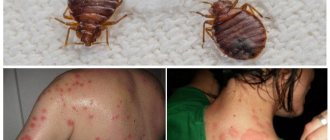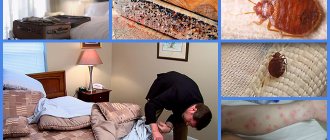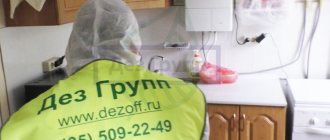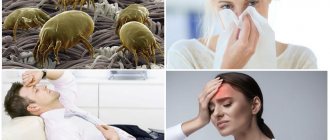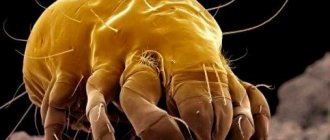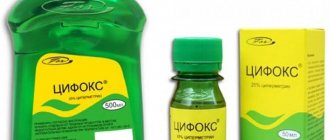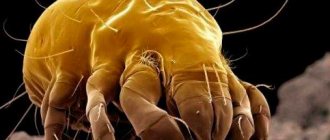Today we don't even think about the huge hidden danger that we come into contact with every day. Yes, we will talk about bed mites, which surround us everywhere. First of all, there are a lot of pests in mattresses, blankets and pillows. But what do they look like, you ask? These are microscopic insects belonging to the order of exoparasites, which can cause much more damage to human health than might seem at first glance. Today we will tell you in more detail about these parasites.
Harm from bed mites.
Many people mistakenly believe that despite their small size, opponents cannot yet cause any harm to a person; when microparasites penetrate the human respiratory tract, they can easily lead to serious problems. First of all, with the lungs and respiratory tract. Often, people who are constantly surrounded by dust mites in their apartment begin to suffer from dangerous respiratory diseases such as asthma or chronic bronchitis. In addition, bed ticks can carry various types of fever of varying levels of danger, so insects must be subject to mandatory destruction in the apartment. And it is advisable to do this as soon as possible. Pests also feed on blood and can change its composition.
Borreliosis
This disease occurs with damage to the nervous system, joints, heart, skin, and very often becomes chronic. 10-14 days after the bite, the early stage of the disease begins:
| General symptoms | Specific symptoms |
|
|
Stage of spread of infection (2-3 weeks - 2-3 months after the bite)
| Nervous system | Lumbar pain, facial pain along the nerves due to their inflammation. Decreased memory, impaired thinking processes |
| Heart | Pericarditis, myocarditis, arrhythmia |
| Leather | Transient red rash. Nodular and tumor-like elements |
| Eyes | Iritis, conjunctivitis |
| Respiratory system | Tracheitis, bronchitis |
| Joints | Arthritis and polyarthritis |
Bed tick bites.
Initially, many people who experience parasitism of bed mites in an apartment may simply not notice the parasites, but within a few weeks after the pests infest the apartment, symptoms begin to actively manifest themselves. what not Many people experience a feeling of itching and irritation in the skin. These are bed tick bites. As a rule, parasites do not attack a person alone, but with a huge army of insects, so they can quickly and effectively drink blood for themselves. When pests bite a person, many begin to experience allergic reactions. In addition, people report fever, dizziness, fear of light and discomfort in the armpits. These are the most common symptoms of bed tick bites. The most dangerous thing is the triatomine mite - it is a small parasite that enters into absolutely secretive life activity and may practically not manifest itself at all in the first few months of a person’s presence in a person’s apartment, which is quite dangerous.
Forms of encephalitis
The target organ of the disease is the brain (see statistics on tick-borne encephalitis). There are several forms of encephalitis, which have their own clinical characteristics.
- Feverish form
Diagnosed in 40-50% of cases. Fever, the main symptom of the disease, lasts 5-6 days at a level of 38-40 C. After the temperature drops, the main symptoms disappear, but weakness and lethargy remain for several more weeks. Complications occur very rarely.
- Meningeal form
This is 50-60% of cases. It occurs with severe general intoxication (hyperthermia over 38 C, fever, chills, sweating, high-intensity headache), as well as symptoms of inflammation of the meninges: nausea and vomiting, decreased elasticity of the occipital and neck muscles (difficulty when trying to bring the chin to the neck), facial asymmetry, dilated pupils. Recovery is long, remission occurs in a state of weakness and weakness. Chronitization of the process is possible.
- Focal form
The heaviest downstream. Characteristics: high temperature, impaired consciousness with delusions and hallucinations, severe intoxication, convulsions, disorientation in space, impaired breathing and heart function. Most often it becomes chronic.
- Chronic form
Develops over several months and even years after the disease. Frequency - 1-3% of cases of the total number of cases. The patient experiences constant twitching of the muscles of the neck, shoulder girdle and face, tendon reflexes and muscle tone in the limbs decrease, the psyche is disturbed, and dementia develops.
How to get rid of bed mites.
Many people ask the question: “Is it possible to get rid of bed mites in an apartment or private house on your own?” At first glance, it seems that this task is simply impossible, because how can you destroy the smallest pests that you can’t even see? However, this can be done quite realistically by raising the temperature in the apartment. Bed mites are very unstable to heat, so our company’s specialists recommend ironing and washing all bed linen, curtains, towels, blankets, pillows, and upholstered furniture surfaces at high temperature in a washing machine, and then douse them with boiling steam using a steam generator. There are other ways, but this one is the most effective. You can also try using anti-bed mite chemicals, which you can purchase at hardware stores. Otherwise, if the remedies do not help, it is better to seek professional help from a specialized sanitary and epidemiological control service in your city, where they will definitely help you solve the existing problem.
Crimean hemorrhagic fever
A severe viral disease transmitted through the bites of ticks of the genus Hyaloma. The disease is widespread in the Astrakhan, Rostov and Volgograd regions, Krasnodar and Stavropol territories, Volgograd regions, Dagestan, Kalmykia, Central Asia, China, southern Ukraine, and Crimea.
Symptoms of the disease
- Occurs within 2-14 days after the bite.
- The initial period lasts 3-4 days: severe hyperemia, intense headache, body aches, especially in the lower back, severe weakness, vomiting, lack of appetite, dizziness, impaired consciousness.
- During the peak period, there is an abrupt decrease in t - first it drops for 1-1.5 days, then it rises and lasts up to 7 days, after which it falls again. There is a petechial rash on the chest and sides of the abdomen, bleeding gums, bleeding from the ears and eyes, internal organs, and nose. The condition worsens sharply, blood pressure drops, tachycardia, lethargy, and confusion occur. The mortality rate reaches 25%.
- During the recovery period, which lasts from several months to 1-2 years, a person feels weakness and fatigue, heart pain, dizziness and headaches, and a decrease in blood pressure.
What not to do if you are bitten by a tick
- Panic. Absurd actions in such a situation are definitely not necessary. Remember - not every tick is contagious, but it’s too early to relax.
- Removing a tick from the skin with bare hands means there is a risk of the virus entering the body through micro-cuts in the skin.
- Touch eyes and mucous membranes with hands that touched the tick.
- Use oil and other liquids to deprive the tick of oxygen - in this case, the aggressiveness of the tick increases.
- Squeezing or sharply pulling out the tick will allow saliva and gastric contents to enter the wound. A sharp pull out of the tick threatens to rupture it - part of the arthropod will remain in the body.
Destruction of bed mites with folk remedies
In addition to all the available chemicals and means for self-treatment, you can also use various folk remedies for killing bed mites in the apartment. With their help, you can make a solution and treat all furniture surfaces in the apartment. Firstly, you can use the method of evaporating dust mites using a high-temperature steam generator. You can also try using valerian tincture, which will need to be thoroughly treated and sprayed on all surfaces of the furniture in the apartment, as well as on pillows, blankets, towels, and all bedding in the apartment during the day. Usually a tincture of kerosene and turpentine helps to cope well with these pests. It is necessary to mix the two components with water, and then treat all surfaces, as is the case with other solutions and tinctures of drugs.
Thirdly, you can also try treating all the furniture with tinctures of essential oils that repel bed ticks. In addition, if all of the above remedies do not help, use the freezing method. A moderate decrease in temperature in the apartment also helps to get rid of bed mites, in a word, as does an increase in air temperature.
What to process
First of all, remember that you should not lubricate the tick with oil or cream in the hope that it will come out on its own. Rely on yourself better.
You can treat a tick bite on a person with soap and water, and then it would be a good idea to walk over it with an antiseptic. You can use alcohol or chlorhexidine, which is sold at any pharmacy. Alternatively, 5% iodine, cologne, or any disinfectant that is at hand will do.
If the tick's proboscis breaks and remains in the skin, do not try to pick it out; it will come out on its own after some time.
Professional treatment for bed ticks in Moscow
It has been proven and verified that the highest quality and most effective method on the pest control market, which will definitely help you destroy all bed mites in the apartment, is professional treatment in the apartment. Our company’s specialists will help you destroy bed mites throughout your entire apartment in one treatment. Our employees will help you get rid of pests quickly and efficiently, as they use the most modern and proven products that help remove all mites. Our company uses the highest quality and most reliable steam generators, thanks to which we are always able to accurately process bed linen, the surfaces of upholstered furniture in the apartment, rugs and carpets, as well as mattresses using elevated temperatures. This is the only way to remove up to one hundred percent of pests from an apartment. After our work, you will not recognize the apartment, since the air will become much cleaner and more pleasant, and all bed mites will disappear once and for all.
Popular questions and answers
In which regions is there a high risk of contracting encephalitis or borreliosis from a tick?
The majority of bites from infected ticks are recorded in the Urals, Siberia, the Far East and the regions of the Northwestern Federal District. When hiking in these regions, you need to be extremely careful, and even better, get vaccinated in advance. You need to understand that infected ticks can also be found in other parts of Russia; residents of all regions of the country seek medical help because of their bites every year.
Is it true that ticks live on trees?
In fact, ticks are usually located in tall grass, about 30 cm from the ground. This makes it easier for them to cling to the legs of those walking by. For the same reason, ticks especially like to be located near paths; they sense where people and animals most often walk. Sometimes ticks climb onto bushes and lower branches of trees.
Where do ticks usually bite?
A tick bite on a person is usually located in places where the skin is thin; it is easier for the tick to bite through it. They stick in the groin, on the stomach and lower back, in the armpits, on the chest, behind the ears, on the neck and on the scalp. A tick bite on a person looks like a red round spot, and the tick itself, as a rule, is located on it, plunging its proboscis under the skin.
Is it possible to fill a tick with oil or alcohol?
A common misconception is that if you pour oil, gasoline, alcohol, or grease onto a tick, it will suffocate and fall off on its own. Nothing of the kind, with your manipulations you can only spur the tick to stick tighter. It is better to treat the tick bite with antiseptics, for example, alcohol or vodka, just water and soap will do, and then pull it out with tweezers.
What to do if it is not possible to take a tick for analysis?
Observe the condition of the injured person. If the inflammation at the site of the tick bite disappears within 1-2 days, the likelihood of developing any disease is considered minimal. If the swelling remains or worsens, go to the doctor. It will not be superfluous to constantly change the temperature of the victim. If it increases within 10 days of the bite, there is a serious risk of developing an infection, so do not delay visiting a doctor.
What if after a bite you start taking antibiotics just in case?
Such a safety net is pointless and dangerous. Firstly, not every tick is infected, secondly, not every sick tick will transmit this or that ailment to you, thirdly, it is no coincidence that antibiotics are given according to prescriptions; without the proper knowledge you will not select the optimal drug and dosage. But the worst thing is that delay due to antibiotics can lead to serious problems.
